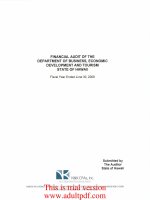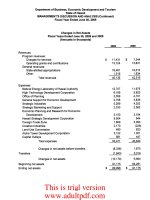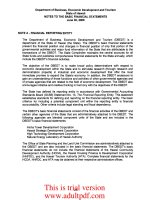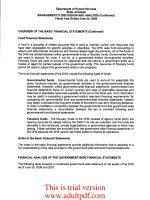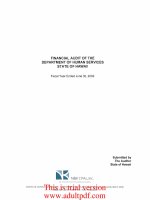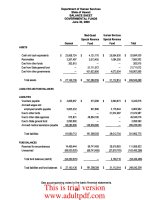Office of the State Treasurer Financial Audit Fiscal Year 1998 Statewide Audit March 1999 Financial Audit Division Office of the Legislative Auditor State of Minnesotac_part1 ppt
Bạn đang xem bản rút gọn của tài liệu. Xem và tải ngay bản đầy đủ của tài liệu tại đây (208.2 KB, 10 trang )
Office of the State Treasurer
Financial Audit
Fiscal Year 1998 Statewide Audit
March 1999
Financial Audit Division
Office of the Legislative Auditor
State of Minnesota
99-16
Centennial Office Building, Saint Paul, MN 55155 651/296-4708
SUMMARY
State of Minnesota
Office of the Legislative Auditor
1st Floor Centennial Building
658 Cedar Street • St. Paul, MN 55155
(651)296-1727 • FAX (651)296-4712
TDD Relay: 1-800-627-3529
email:
URL:
Office of the State Treasurer
Financial Audit
Fiscal Year 1998 Statewide Audit
Public Release Date: March 12, 1999 No. 99-16
Background
The State Treasurer is a constitutional officer elected by the citizens of Minnesota to a four-year
term. Michael A. McGrath served as State Treasurer from January 1987 until January 1999. On
January 4, 1999, Carol Johnson was sworn in as the new State Treasurer. During the November
1998 elections, the voters of Minnesota approved a constitutional amendment abolishing the
Office of the State Treasurer effective at the conclusion of Carol Johnson’s current four-year
term. The Office of the State Treasurer provides banking services for most state agencies. This
function includes cash control, receipt processing, and warrant redemption. In addition, the
office makes debt service payments on outstanding general obligation bonds and collects various
fees and assessments transmitted from the 87 counties. The State Treasurer also serves as a
member of the State Board of Investment, the Minnesota State Retirement System Board, and the
Executive Council.
Selected Audit Areas and Conclusions
Our work in the Office of the State Treasurer is completed as part of our annual Statewide Audit.
Our audit scope focused on those areas material to the State of Minnesota's financial statements,
including state depository cash control and debt service expenditures. In addition, we expanded
our audit scope beyond Statewide Audit objectives to review the Office of the State Treasurer’s
revenue collections and administrative expenditures for the period July 1, 1997, to December 31,
1998.
We qualified our report, dated December 1, 1998, on the State of Minnesota’s Comprehensive
Annual Financial Report because insufficient audit evidence exists to support the State of
Minnesota’s disclosures with respect to the year 2000. Auditing the state’s year 2000
compliance efforts was not an objective of this audit. As a result, we do not provide assurance
that the Office of the State Treasurer is or will be year 2000 ready, that its year 2000 remediation
efforts will be successful in whole or in part, or that parties with which the Office of the State
Treasurer does business will be year 2000 ready. We concluded that internal controls over the
areas reviewed provide reasonable assurance that assets were adequately safeguarded, and
transactions were authorized and properly reported in the accounting records. We also
concluded that the office complied with material legal provisions related to the areas reviewed,
except that the Office of the State Treasurer needs to improve controls over travel costs.
The Office of the State Treasurer agreed with our recommendation and will take corrective
action to resolve the situation.
STATE OF MINNESOTA
OFFICE OF THE LEGISLATIVE AUDITOR
JAMES R. NOBLES, LEGISLATIVE AUDITOR
Representative Dan McElroy, Chair
Legislative Audit Commission
Members of the Legislative Audit Commission
The Honorable Carol Johnson
State Treasurer
We have audited the Office of the State Treasurer for the fiscal year ended June 30, 1998, as
further explained in Chapter 1. The work conducted in the Office of the State Treasurer is part of
our Statewide Audit of the State of Minnesota's fiscal year 1998 financial statements. We
qualified our report, dated December 1, 1998, on the State of Minnesota’s general purpose
financial statements because insufficient audit evidence exists to support the State of Minnesota’s
disclosures with respect to the year 2000. Auditing the state’s year 2000 compliance efforts was
not an objective of this audit. As a result, we do not provide assurance that the Office of the
State Treasurer is or will be year 2000 ready, that its year 2000 remediation efforts will be
successful in whole or in part, or that parties with which the Office of the State Treasurer does
business will be year 2000 ready.
We conducted our audit in accordance with generally accepted auditing standards and
Government Auditing Standards, as issued by the Comptroller General of the United States.
Those standards require that we obtain an understanding of management controls relevant to the
audit. The standards require that we design the audit to provide reasonable assurance that the
Office of the State Treasurer complied with provisions of laws, regulations, contracts, and grants
that are significant to the audit. Management of the Office of the State Treasurer is responsible
for establishing and maintaining the internal control structure and complying with applicable laws,
regulations, contracts, and grants.
We prepared this report for the information of the Legislative Audit Commission and the
management of the Office of the State Treasurer. However, we do not limit the distribution of
this report, which was released as a public document on March 12, 1999.
James R. Nobles Claudia J. Gudvangen, CPA
Legislative Auditor Deputy Legislative Auditor
End of Fieldwork: February 5, 1999
Report Signed On: March 8, 1999
1ST FLOOR SOUTH, CENTENNIAL BUILDING 658 CEDAR STREET ST. PAUL, MN 55155
TELEPHONE 651/296-4708 TDD RELAY 651/297-5353 FAX 651/296-4712 WEB SITE
Office of the State Treasurer
Table of Contents
Page
Chapter 1. Background 1
Chapter 2. Cash Control 3
Chapter 3. Debt Service Expenditures 5
Chapter 4. Revenue 7
Chapter 5. Administrative Expenditures 9
Status of Prior Audit Issues 13
Office of the State Treasurer’s Response 15
Audit Participation
The following members of the Office of the Legislative Auditor prepared this report:
Claudia Gudvangen, CPA Deputy Legislative Auditor
Cecile Ferkul, CPA, CISA Audit Manager
Tony Toscano Auditor-in-Charge
Laura Peterson, CPA Auditor
Terry Hanson, CPA Auditor
Neal Dawson Auditor
Crystal Eskridge Auditor
Rick Weinmeyer Auditor
Dan Kingsley Auditor
Exit Conference
We discussed the results of the audit with the following staff of the Office of the State Treasurer
at an exit conference on February 25, 1999:
Carol Johnson State Treasurer
John Manahan Deputy State Treasurer
Jerry Engebretson Director of Treasury Operations
Office of the State Treasurer
1
Chapter 1. Background
The State Treasurer is a constitutional officer elected by the citizens of Minnesota to a four-year
term. Michael A. McGrath served as State Treasurer from January 1987 until January 1999,
when Carol Johnson was sworn in as the new State Treasurer. The State Treasurer also serves as
a member of the State Board of Investment, the Minnesota State Retirement System Board, and
the Executive Council.
Our work in the Office of the State Treasurer is completed as part of our annual Statewide Audit.
The primary objective of the Statewide Audit was to render an opinion on the State of
Minnesota's financial statements included in its Comprehensive Annual Financial Report for
fiscal year 1998. This included determining whether the financial statements of the state
presented fairly its financial position, results of operations, and changes in cash flows in
conformity with generally accepted accounting principles. As part of our work, we were
required to gain an understanding of the internal control structure and ascertain whether the state
complied with laws and regulations that may have a material effect on its financial statements.
We qualified our report, dated December 1, 1998, on the State of Minnesota’s Comprehensive
Annual Financial Report because insufficient audit evidence exists to support the State of
Minnesota’s disclosures with respect to the year 2000. Auditing the state’s year 2000
compliance efforts was not an objective of this audit. As a result, we do not provide assurance
that the Office of the State Treasurer is or will be year 2000 ready, that its year 2000 remediation
efforts will be successful in whole or in part, or that parties with which the Office of the State
Treasurer does business will be year 2000 ready. We concluded that internal controls over the
areas reviewed provide reasonable assurance that assets were adequately safeguarded, and
transactions were authorized and properly reported in the accounting records. We also
concluded that the office complied with material legal provisions related to the areas reviewed,
except that the Office of the State Treasurer needs to improve controls over travel costs.
Our financial statement audit scope focused on the State Treasurer's responsibilities in the
following areas that were material to the state's financial statements in the fiscal year ended
June 30, 1998:
• state depository cash control, including receipt collections and warrant redemptions, and
• debt service expenditures.
In addition to the statewide audit scope, we reviewed other financial activities administered by
the Office of the State Treasurer for the period July 1, 1997 to December 31, 1998. Our audit
scope included the following areas:
• revenue,
• bank fees,
• payroll, and
• travel.
Office of the State Treasurer
2
To address our financial statement and agency objectives, we interviewed key agency
employees, reviewed applicable policies and procedures, tested representative samples of
financial transactions, and performed analytical procedures, as appropriate. Our specific audit
work is discussed more fully in the following chapters.
Office of the State Treasurer
3
Chapter 2. Cash Control
Chapter Conclusions
The Office of the State Treasurer designed state depository internal controls to
provide reasonable assurance that cash was adequately safeguarded, and that
transactions were authorized and properly reported in the accounting records.
The cash balance recorded on the State Treasurer's records was supported by
the underlying transactions and bank account records. In addition, for the
items tested, the Office of the State Treasurer complied with applicable legal
provisions.
The Office of the State Treasurer provides banking services for most state agencies. The office
interacts with the Department of Finance, which provides accounting and other services, and the
State Board of Investment, which invests state monies. The office accounts for money deposited
by state agencies in the state treasury until it is lawfully disbursed or invested. Receipt
transactions, including investment redemptions and maturities, totaled $21.8 billion in fiscal year
1998.
Another function of the office is to verify and redeem state warrants used by state agencies to
satisfy lawful obligations of the state. The Treasurer's Office determines that the items submitted
by the banks are valid outstanding warrants before transferring funds to the banks for payment.
The Treasurer’s Office also maintains records detailing the daily balance of outstanding
warrants. During fiscal year 1998, the Treasurer's Office processed warrants totaling
approximately $13 billion. In addition, the office initiated $6.3 billion automatic clearing house
transactions based on Department of Finance and other state agency authorizations.
The Office of the State Treasurer monitors collateral pledged to secure funds deposited in the
various state depository accounts. Pursuant to statutory requirements, state deposits cannot
exceed 90 percent of the market value of the collateral pledged by the bank. The State
Treasurer's system monitors the collateral balance and identifies when insufficient coverage
exists. At June 30, 1998, banks pledged $80.1 million in collateral to secure depository
accounts.
Audit Objectives and Methodology
The primary objectives of our audit were to answer the following questions:
• Did the Office of the State Treasurer design internal controls to provide reasonable
assurance that cash was adequately safeguarded, and transactions were authorized and
properly reported in the accounting records?
Office of the State Treasurer
4
• Was the cash balance reported on the Office of the State Treasurer's accounting records
supported by bank account records?
• Did the Office of the State Treasurer comply with material legal provisions in
administering state depository accounts?
To address our financial statement objectives, we interviewed key department employees to gain
an understanding of applicable policies and procedures. We confirmed bank balances at June 30,
1998, and December 31, 1998, and tested the State Treasurer's bank account reconciliations. In
conjunction with our audit of the Department of Finance, we reviewed and tested supporting
documentation for reconciliations of cash receipt and disbursement transactions recorded on the
Minnesota Accounting and Procurement System (MAPS) and the State Treasurer's depository
accounting system. We reviewed the controls over warrant and automatic clearing house
transactions and verified the reconciliation of outstanding warrants as recorded on MAPS to the
State Treasurer's outstanding warrant balance at June 30, 1998. We also tested compliance with
Minn. Stat. Section 9.031, pertaining to the adequacy of collateral coverage.
Conclusions
State depository internal controls provide reasonable assurance that cash was adequately
safeguarded, and transactions were authorized and properly reported in the accounting records.
The cash balance recorded on the State Treasurer's records was supported by the underlying
transactions and bank account records. In addition, for the items tested, the Office of the State
Treasurer materially complied with applicable legal provisions.
Office of the State Treasurer
5
Chapter 3. Debt Service Expenditures
Chapter Conclusions
Internal controls over general obligation bond debt service payments provide
reasonable assurance that expenditures are accurate and properly reported in
the accounting records. The Office of the State Treasurer appropriately paid
$300 million in principal and interest on general obligation bonds during fiscal
year 1998. For the items tested, the Office of the State Treasurer complied with
applicable legal provisions for debt service payments.
As provided in the State Constitution, the State Treasurer maintains records and makes payments
for principal and interest on the state's general obligation bonds. At June 30, 1998, the
outstanding general obligation bonds payable totaled $2.51 billion. During fiscal year 1998, the
State Treasurer made debt service payments totaling approximately $300 million.
Audit Objectives and Methodology
The primary objectives of our audit were to answer the following questions:
• Did the Office of the State Treasurer design internal controls to provide reasonable
assurance that debt service expenditures were authorized and properly reported in the
accounting records?
• Did debt service payments comply with applicable amortization schedules and other
material legal provisions?
To address our financial statement objectives, we interviewed key department employees to gain
an understanding of applicable policies and procedures and performed analytical procedures, as
appropriate. In addition, we verified the debt service payments to the amortization schedules
prepared by the Department of Finance.
Conclusions
Internal controls over general obligation bond debt service payments provide reasonable
assurance that expenditures are accurate and properly reported in the accounting records. The
Office of the State Treasurer appropriately paid $300 million in principal and interest on general
obligation bonds during fiscal year 1998. The Office materially complied with applicable legal
provisions for debt service payments.
Office of the State Treasurer
6
This page intentionally left blank.
